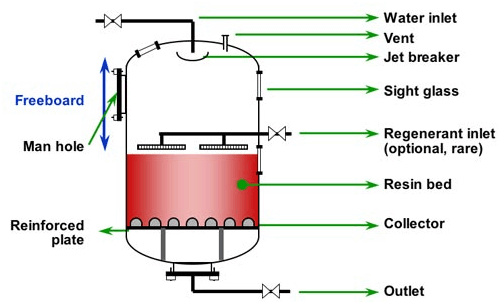Deionization, as the name explains is a term normally used for reduction of charged ions to very low levels. Deionization is also alternatively called as Demineralization. The deionization is normally a two stage process. In first stage the cations & in second stage anions are removed respectively. Sometimes a polisher unit called mixed bed is also employed when the water quality requirement is stringent.
Basic Chemistry
The DI/DM process is carried out in ion exchange resin columns where the water with dissolved ions/minerals is passed through resin bed. The cations and anions are exchanged with loosely attached Hydrogen (SO3-H/COO-H) or Hydroxyl (N-OH/NH2-OH) ion of the resin bead.
The ion exchange resins, commonly also called IX resins are primarily manufactured by cross polymerization of Styrene & Divinyl Benzene. The cross linking is done from 6 -12% based on required hydraulic as mechanical properties. The IX reactions are reversible & resins need to be regenerated by acid and alkali re-generants once these are exhausted. Normally strong Acids like Hydrochloric/Sulfuric & Caustic is used. Generally 4- 8% concentration is used for regeneration, however it differs with respect to the incoming water quality.
Configurations
There are many variations in column design too.
In vessel configuration the two basic types are down flow & Up flow design. In Downflow vessels regeneration is carried out in two methods
1. Co-Flow Unit – The regenerant flows in same direction as that of water.
2. Counter-Flow Unit – In this design the regenerant flows in opposite direction as that of water. This method is usually envisaged where very low leakage levels are expected.
The very large polishers have external regeneration systems also.
Schemes
The required scheme is normally decided based on feed water quality, outlet quality required and flow rate between two regenerations. Following schemes are normally employed.
1. Strong Acid Cation – Strong Base Anion
2. Strong Acid Cation – Degasser – Strong Base Anion
3. Strong Acid Cation – Degasser – Weak Base Anion – Strong Base Anion
4. Weak Acid Cation –Strong Acid Cation – Degasser – Weak Base Anion – Strong Base Anion
A Mixed Bed is added if the quality requirements are stringent.
Ion Exchange Resin Types:
Major resin types & applications are tabulated below:
|
S.No. |
Resin Description |
Application |
Remark |
| 1 | Strong Acid Cation | Removal of all Cations | Same resin is used for softening in Na form. |
| 2 | Strong Base Anion | Removal of all anions including reactive SiO2 | This resin comes as Type I & II. The grade is selected based on influent characteristics. |
| 3 | Weak Base Anion | Removal of Chlorides & Sulphates | Used when Mineral Acidity of feed is high. |
| 4 | Weak Acid Cation | Removal of Hardness | Used when Alkalinity linked Hardness is high. |
TYPICAL ION EXCHANGE COLUMN
Ion exchange resins are used in pressurised columns, in principle similar to those used for sand filters or activated carbon. These are pressure vessels, usually made of rubber-lined steel. Small units are made of fiber glass reinforced plastic, and units used in the food industry are often made of stainless steel.
A typical ion exchange column with co-flow regeneration is represented below:
Some explanations about the details shown in the picture:
- The water enters from the top of the column. So as not to disturb the surface of the resin bed, the incoming water stream is stopped by a simple jet breaker.
- The column has a large freeboard, usually about the same height as the resin bed, so that the resin can be backwashed inside the column to remove suspended solids accumulated on the bed surface.
- A manhole (shown on the left side) is necessary to inspect and possibly repair the column inside.
- Two sight glasses are also shown, one at the top, one at the level of the resin bed surface.
- An air vent is also necessary at the top, to empty the column by draining the water out for inspection or a resin change.
- One of the most important features of the vessel is the collector at the bottom: nowadays, one of the most popular types of collector is a plate with densely distributed nozzles.
- A regenerant distributor is mounted in the middle of the vessel to ensure a uniform distribution of the regenerant. In absence of such a collector, the regenerant is introduced from the top of the column, which results in some dilution of the chemicals.
- Most of the features of the above column (vent, sight glasses, nozzle plates, manhole) are common to many types of column, regenerated in co-flow or in reverse flow.
Applications
Deionization finds applications almost all industries where Steam is used from Process Industry or Power Plants to Semi-Conductor Industry.
Major Application are listed below:
- Thermal & Nuclear Power Plants
- Semi-Conductor Industry
- Process Industry
- Fs
- Pharmaceutical Industry
- Sugar Industry


